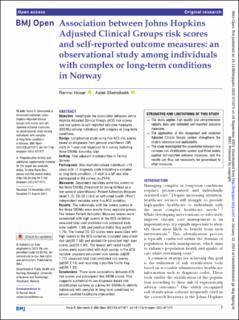| dc.contributor.author | Hosar, Rannei | |
| dc.contributor.author | Steinsbekk, Aslak Irgens | |
| dc.date.accessioned | 2024-02-28T15:05:51Z | |
| dc.date.available | 2024-02-28T15:05:51Z | |
| dc.date.created | 2023-09-19T17:44:53Z | |
| dc.date.issued | 2023 | |
| dc.identifier.issn | 2044-6055 | |
| dc.identifier.uri | https://hdl.handle.net/11250/3120353 | |
| dc.description.abstract | Objective - Investigate the association between Johns Hopkins Adjusted Clinical Groups (ACG) risk scores and low scores in self-reported outcome measures (SROMs) among individuals with complex or long-term conditions.
Design - Longitudinal study using five ACG risk scores based on diagnoses from general practitioner (GP) visits in 1 year and responses to a survey including three SROMs 4 months later.
Setting - Four adjacent municipalities in Central Norway.
Participants - Non-institutionalised individuals ≥18 years with ≥1 diagnosis code indicating a complex or long-term condition, ≥1 visit to a GP, and who participated in the survey (n=2944).
Measures - Dependent variables were low scores in the three SROMs (threshold for being defined as a low score in parentheses): Patient Activation Measure (level 1–2), EQ-5D (<0.4) or self-rated health (‘Poor’). Independent variables were five ACG variables.
Results - The individuals with the lowest scores in the three SROMs were mostly three separate groups. The lowest Patient Activation Measure scores were associated with high scores in the ACG variables unscaled total cost predicted risk (adjusted odds ratio (adjOR) 1.80) and positive frailty flag (adjOR 1.76). The lowest EQ-5D scores were associated with high scores in the ACG variables unscaled concurrent risk (adjOR 1.60) and probability persistent high user scores (adjOR 2.83). The lowest self-rated health scores were associated with high scores in the ACG variable unscaled concurrent risk scores (adjOR 1.77), unscaled total cost predicted risk scores (adjOR 2.14) and receiving a positive frailty flag (adjOR 1.82).
Conclusions - There were associations between ACG risk scores and subsequent low SROM scores. This suggests a potential to use diagnosis-based risk stratification systems as a proxy for SROMs to identify individuals with complex or long-term conditions for person-centred healthcare intervention. | en_US |
| dc.language.iso | eng | en_US |
| dc.publisher | BMJ Publishing Group | en_US |
| dc.rights | Navngivelse-Ikkekommersiell 4.0 Internasjonal | * |
| dc.rights.uri | http://creativecommons.org/licenses/by-nc/4.0/deed.no | * |
| dc.title | Association between Johns Hopkins Adjusted Clinical Groups risk scores and self-reported outcome measures: an observational study among individuals with complex or long-term conditions in Norway | en_US |
| dc.title.alternative | Association between Johns Hopkins Adjusted Clinical Groups risk scores and self-reported outcome measures: an observational study among individuals with complex or long-term conditions in Norway | en_US |
| dc.type | Peer reviewed | en_US |
| dc.type | Journal article | en_US |
| dc.description.version | publishedVersion | en_US |
| dc.source.volume | 13 | en_US |
| dc.source.journal | BMJ Open | en_US |
| dc.source.issue | 9 | en_US |
| dc.identifier.doi | 10.1136/bmjopen-2022-071071 | |
| dc.identifier.cristin | 2176719 | |
| cristin.ispublished | true | |
| cristin.fulltext | original | |
| cristin.qualitycode | 1 | |

